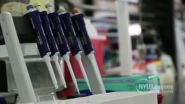(Press-News.org) Pregnant women living near the World Trade Center during 9/11 experienced higher-than-normal negative birth outcomes, according to a new working paper by Princeton University's Woodrow Wilson School of Public and International Affairs.
These mothers were more likely to give birth prematurely and deliver babies with low birth weights. Their babies - especially baby boys - were also more likely to be admitted to neonatal intensive care units after birth. The study, led by the Wilson School's Janet Currie and Hannes Schwandt, was released by the National Bureau of Labor Economics in August.
"Previous research into the health impacts of in utero exposure to the 9/11 dust cloud on birth outcomes has shown little evidence of consistent effects. This is a puzzle given that 9/11 was one of the worst environmental catastrophes to have ever befallen New York City," said Currie, Henry Putnam Professor of Economics and Public Affairs, director of the economics department and director of the Wilson School's Center for Health and Wellbeing. "Our work suggests a simple resolution of this puzzle, which is that the women who lived in neighborhoods exposed to the 9/11 dust cloud had very different experiences than women in other parts of New York City."
The collapse of the two towers created a zone of negative air pressure that pushed dust and smoke into the avenues surrounding the World Trade Center site. Other past studies have shown that environmental exposure to the World Trade Center dust cloud was associated with significant adverse effects on the health of adult community residents and emergency workers.
Using data on all births that were in utero on Sept. 11, 2001 in New York City and comparing those babies to their siblings, the researchers found that, for mothers in their first trimester during 9/11, exposure to this catastrophe more than doubled their chances of delivering a baby prematurely. Of the babies born, boys were more likely to have birth complications and very low birth weights. They were also more likely to be admitted to the NICU.
The neighborhoods most affected by the 9/11 dust cloud included Lower Manhattan, Battery Park City, SoHo, TriBeCa, Civic Center, Little Italy, Chinatown and the Lower East Side. Previous studies analyzing the aftermath of 9/11 on health failed to account for many women living in Lower Manhattan, who were generally less likely to have poor birth outcomes than women living in other neighborhoods.
INFORMATION:
The paper, "The 9/11 Dust Cloud and Pregnancy Outcomes: A Reconsideration," can be found on NBER.
9/11 dust cloud may have caused widespread pregnancy issues
2014-08-14
ELSE PRESS RELEASES FROM THIS DATE:
Reduced testosterone tied to endocrine-disrupting chemical exposure
2014-08-14
Washington, DC—Men, women and children exposed to high levels of phthalates - endocrine-disrupting chemicals found in plastics and some personal care products – tended to have reduced levels of testosterone in their blood compared to those with lower chemical exposure, according to a new study published in the Endocrine Society's Journal of Clinical Endocrinology & Metabolism (JCEM).
Testosterone is the main sex hormone in men. It contributes to a variety of functions in both sexes, including physical growth and strength, brain function, bone density and cardiovascular ...
Vitamin D Deficiency May Reduce Pregnancy Rate in Women Undergoing IVF
2014-08-14
Washington, DC—Women with a vitamin D deficiency were nearly half as likely to conceive through in vitro fertilization (IVF) as women who had sufficient levels of the vitamin, according to a new study published in the Endocrine Society's Journal of Clinical Endocrinology & Metabolism (JCEM).
Long known for its role in bone health, vitamin D is a steroid hormone that is emerging as a factor in fertility. Animal studies have shown that the hormone, which is produced in the skin as a result of sun exposure as well as absorbed from some fortified foods, affects fertility ...
Scripps Research Institute chemists uncover powerful new click chemistry reactivity
2014-08-14
LA JOLLA, CA—August 14, 2014—Chemists led by Nobel laureate K. Barry Sharpless at The Scripps Research Institute (TSRI) have used his click chemistry to uncover unprecedented, powerful reactivity for making new drugs, diagnostics, plastics, smart materials and many other products.
The new SuFEx—Sulfur Fluoride Exchange—reactions enable chemists to link molecules of their choice together using derivatives of a common commercial chemical considered essentially inert. The Sharpless team made this chemical reliably and predictably reactive. Astonishingly, acid-base constraints ...
Adults with autism at higher risk of sexual victimization: York University study
2014-08-14
Adults with autism are at a higher risk of sexual victimization than adults without, due to lack of sex education, but with improved interventions that focus on sexual knowledge and skill building, the risk could be reduced, according to a recent study by York University researchers.
"Adults with Autism Spectrum Disorder (ASD) gain more of their sexual knowledge from external sources such as the internet and the television whereas social sources would include parents, teachers and peers," says Professor Jonathan Weiss in the Faculty of Health and the CIHR Chair in Autism ...
Predicting fracking policy
2014-08-14
Hydraulic fracturing is emerging as one of the primary methods of drilling for natural gas, yet is equally controversial in its potential to induce harm to humans and the environment. The uncertainties of the health risks associated with horizontal drilling using fluid pressure to break down shale formations for natural gas extraction has pushed countries worldwide to proactively regulate the use of this technology, such as a temporary ban in Germany in 2012 and a ban in France in 2011. Where such decisions are hedged on a variety of metrics ranging from social resistance ...
Freeways as fences, trapping the mountain lions of Los Angeles
2014-08-14
That mountain lions have managed to survive at all in the Santa Monica Mountains of California—in the vicinity of the megacity of Los Angeles—is a testament to the resilience of wildlife, but researchers studying these large carnivorous cats now show in the Cell Press journal Current Biology on August 14 that the lions are also completely isolated, cut off from other populations by the freeway. According to the researchers' analyses, only one young mountain lion successfully dispersed into the Santa Monica Mountains in a decade.
Due to their almost complete isolation, ...
RNA-targeted drug candidate for Lou Gehrig's disease found
2014-08-14
By targeting RNA molecules that tangle and clump in the nervous systems of patients with the most common genetic form of amyotrophic lateral sclerosis (ALS or Lou Gehrig’s disease) and frontotemporal dementia (FTD), researchers have shown they can effectively limit those damaging elements in cells taken from patients. The results reported in the Cell Press journal Neuron on August 14th show that RNA is a viable drug target for the two overlapping and incurable neurodegenerative diseases. The abnormal proteins derived from that aberrant RNA might also serve as biomarkers ...
Disruption of gut bacteria early in life can lead to obesity in adulthood
2014-08-14
Certain microbes found in the gut may protect against obesity and diabetes. A study published by Cell Press August 14th in the journal Cell reveals that these microbes shape their hosts' metabolism very early in life and that disrupting them with short-term exposure to antibiotics during infancy can cause metabolic changes that appear to increase the risk of obesity in adulthood. These findings in mice are helping researchers identify which gut bacteria are crucial to metabolic health. Such information could be used to help restore levels of those helpful microbes after ...
New shock-and-kill approach could eradicate barrier to curing HIV
2014-08-14
Despite tremendous progress in combatting HIV-1 infection with antiretroviral therapy, there is still no cure for the disease because these drugs do not kill a hidden reservoir of infected cells in the body. A study published by Cell Press August 14th in the journal Cell reveals a multipronged strategy for eradicating this latent reservoir and preventing HIV-1 from rebounding after treatment is stopped in mice. The findings suggest that a "shock-and-kill" approach involving the activation of dormant viruses with drugs called inducers, combined with virus-fighting antibodies, ...
Early antibiotic exposure leads to lifelong metabolic disturbances in mice
2014-08-14
VIDEO:
Martin Blaser, M.D., and Laura Cox, Ph.D., discuss their work on early antibiotic exposure in mice.
Click here for more information.
NEW YORK, August 14, 2014 — A new study published today in Cell suggests that antibiotic exposure during a critical window of early development disrupts the bacterial landscape of the gut, home to trillions of diverse microbes, and permanently reprograms the body's metabolism, setting up a predisposition to obesity. Moreover, the study shows ...


